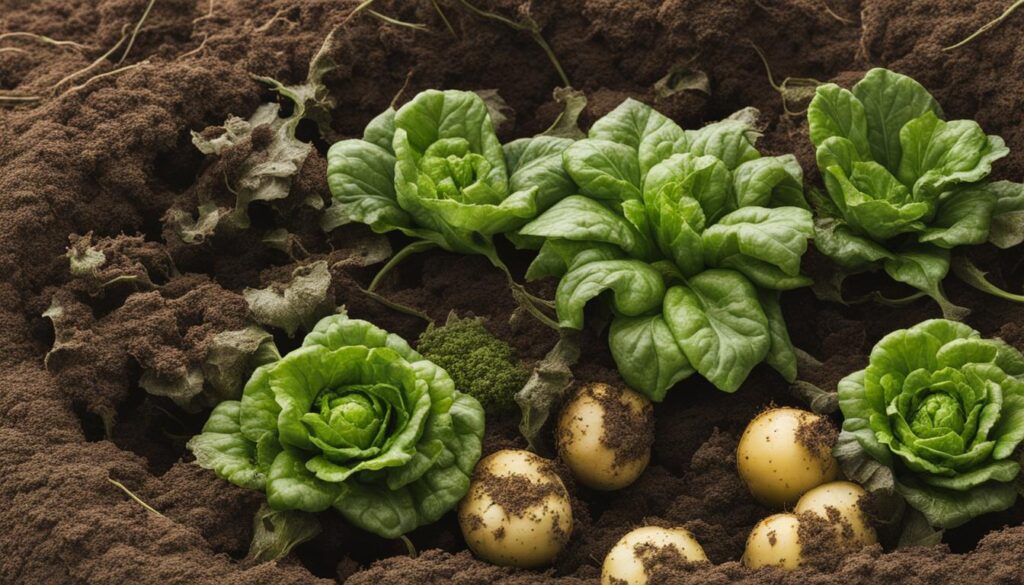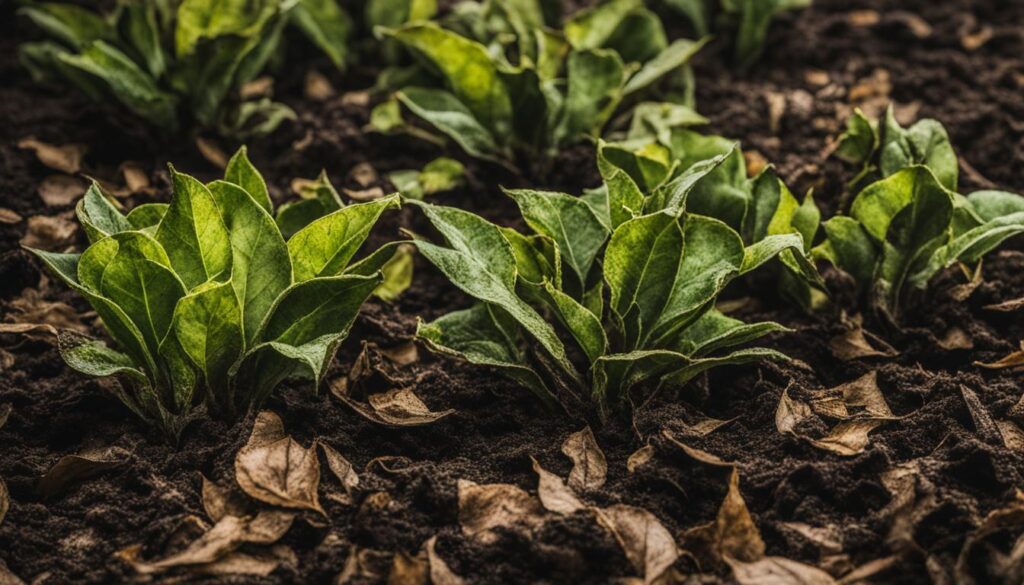Phytophthora Disease is a serious concern for plant health and agriculture. It is caused by various species of soilborne plant pathogens in the genus Phytophthora. These pathogens can affect a wide range of herbaceous and woody plants, including fruit and nut trees, ornamental trees and shrubs, and vegetable crops. Understanding the biology and symptoms of Phytophthora disease is essential for effective management and prevention.
Key Takeaways:
- Phytophthora Disease is caused by soilborne plant pathogens in the genus Phytophthora.
- It affects a wide range of plants, including trees, shrubs, and vegetables.
- Symptoms include wilting, leaf discoloration, and stunted growth.
- Phytophthora thrives in warm, moist conditions and can spread through contaminated soil, water, and plant parts.
- Effective management strategies include good water management, soil drainage, and selection of resistant varieties.
Symptoms of Phytophthora Disease
Plants affected by Phytophthora disease may exhibit various symptoms, including wilting, leaf discoloration, and stunted growth. These symptoms can be indicators of underlying root and crown rot caused by the pathogen. When infected, plants may appear drought-stressed, with wilting leaves that may yellow or redden. In severe cases, the affected plants may die rapidly, especially with the onset of warm weather. It’s important to note that symptoms can initially appear on a single branch or stem, then spread to the rest of the plant, impacting overall health and vitality.
Observing the bark and wood tissue around the crown and upper roots of trees and shrubs can provide additional diagnostic clues. Darkened bark and wood tissue may indicate Phytophthora infection in these plants. In vegetable crops such as tomatoes and eggplants, water-soaked spots on the roots can be observed. These spots later dry out, turning brown and affecting the overall health and productivity of the plants.
Recognizing and understanding these symptoms is crucial in early detection and timely management of Phytophthora disease. Identifying the presence of wilting, leaf discoloration, and stunted growth can guide appropriate intervention measures to prevent further spread and minimize the impact on plant health.
Biology of Phytophthora
Phytophthora species, classified as oomycetes or water molds, are soil-inhabiting pathogens. These resilient organisms produce resting spores that can survive in moist soil for extended periods. When a suitable host plant is nearby and free water is present in the soil, these spores germinate, giving rise to motile spores. These motile spores can directly penetrate the roots, branches, or crowns of susceptible plants. Phytophthora biology thrives in warm and moist conditions, making it a formidable plant pathogen.
Phytophthora can spread through various means, including splashing rain or irrigation water, surface irrigation, runoff water, contaminated soil, equipment, or plant parts. These soil-inhabiting pathogens also have the ability to overwinter in soil and plant debris. With their resting spores, Phytophthora poses a persistent threat to the health of plants and agricultural productivity.
Management of Phytophthora Disease
Effective management of Phytophthora disease is essential to protect plant health and minimize economic losses. There are several key strategies that can be implemented to mitigate the spread and impact of this devastating disease.
Water management plays a critical role in Phytophthora disease management. It is crucial to avoid prolonged saturation of the soil and to prevent standing water around the base of plants. Irrigation should be carefully monitored and done as necessary, using low-angle sprinkler heads or drip systems to avoid wetting the trunk and lower branches of trees.
Soil drainage is another vital aspect to consider. Adequate soil drainage is essential for preventing the buildup of excess moisture, which creates favorable conditions for Phytophthora to thrive. Planting on mounds or raised beds can help improve drainage and reduce the risk of disease.
Selecting resistant rootstocks or varieties is an effective way to manage Phytophthora disease. Resistant varieties have built-in defense mechanisms that can prevent or reduce the severity of infection. By choosing resistant plants, you can significantly decrease the risk of Phytophthora-related damage.
In addition to these measures, crop rotation is highly recommended. Rotating susceptible crops out of affected soil for at least three years can help break the disease cycle and minimize the risk of reinfection. This practice disrupts the pathogens’ life cycle and reduces their ability to survive and infect future crops.
Finally, implementing sanitation practices can slow down the spread of Phytophthora disease. Avoiding the movement of infested soil and infected plant parts minimizes the chances of introducing or spreading the disease to healthy plants.
To effectively manage Phytophthora disease, it is essential to integrate these strategies into an overall disease management plan. By implementing proper water management, improving soil drainage, selecting resistant varieties, practicing crop rotation, and ensuring good sanitation practices, you can reduce the impact of Phytophthora and safeguard the health of your plants.
Phytophthora Disease in Vegetable Crops
Phytophthora disease poses a significant threat to vegetable crops, including cucurbits (pumpkins, squash, melons), peppers, tomatoes, and beans. This destructive disease can cause a range of symptoms such as wilting, root loss, water-soaked lesions on the roots, and even fruit rot. The impact of Phytophthora can be particularly devastating in low-lying and poorly drained areas of fields.
To mitigate the risks associated with Phytophthora disease, preventive measures such as planting in well-drained fields and utilizing raised beds can help reduce the likelihood of infection. Implementing crop rotation practices and selecting resistant varieties are also crucial management strategies to combat Phytophthora in vegetable crops.
It is essential to recognize that Phytophthora can spread through water, making proper drainage and field preparation even more critical. By implementing these preventive measures, growers can safeguard their vegetable crops and minimize the economic impact caused by Phytophthora disease.


Phytophthora Diseases in Nursery Crops
Phytophthora diseases have a significant economic impact on the nursery industry. Nursery crops can be affected by diseases such as rhododendron root rot and sudden oak death, which are caused by Phytophthora species. These diseases can result in crop losses and the need for costly cleanup and destruction of infected plants.
Prevention is key in the nursery industry, through practices such as using certified nursery stock, practicing good sanitation, and selecting resistant varieties. Phytophthora can be long-lived in the soil and requires intensive management.
Implementing preventive measures such as using certified nursery stock can help minimize the risk of introducing Phytophthora diseases into the nursery. Good sanitation practices, such as cleaning and disinfecting tools and equipment, can prevent the spread of the pathogen. Selecting resistant varieties can provide an added layer of protection against Phytophthora infections in nursery crops.
The economic impact of Phytophthora diseases on the nursery industry cannot be ignored. Crop losses and the need for costly cleanup and destruction of infected plants can significantly impact the profitability of nurseries. By implementing effective management strategies and preventive measures, such as using certified nursery stock and practicing good sanitation, nurseries can minimize the risk of Phytophthora diseases and protect their crops.
Preventing Phytophthora Disease in Home Gardens
As a home gardener, I understand the importance of preventing Phytophthora disease in my garden. By implementing certain cultural practices, I can reduce the risk of infection and promote plant health. One such practice is crop rotation, which involves planting different crops in different areas each year. This helps break the disease cycle and prevents the buildup of Phytophthora pathogens in the soil.
Another effective strategy is to choose resistant varieties. These varieties have been bred to withstand Phytophthora infections and are less susceptible to the disease. By selecting resistant varieties when planting my garden, I can ensure that my plants have a better chance of fighting off the pathogens.
Providing good soil drainage is also crucial in preventing Phytophthora disease. Phytophthora thrives in wet conditions, so it’s important to avoid overwatering and ensure that the soil has proper drainage. Raised beds or mounds can be used to improve drainage in areas with heavy clay or poorly draining soil.
To prevent the spread of Phytophthora pathogens, I make sure to avoid working in wet soil. Wet soil can easily transfer the pathogens from one area to another, potentially infecting healthy plants. I also clean my tools and equipment thoroughly after each use to eliminate any traces of the pathogen that may be present.
Correctly identifying and managing any vegetable issues in my garden is another important step in preventing Phytophthora disease. Early detection and proper management of plant diseases can help prevent the spread of pathogens and protect the overall health of my garden.
Managing Phytophthora Disease in Farms
Phytophthora disease can be particularly challenging to manage in farms due to its water-driven nature. As an experienced farmer, I understand the importance of implementing effective strategies to minimize the impact of this devastating pathogen.
In order to successfully manage Phytophthora disease in farms, it is crucial to scout for symptoms in low spots and fields with surface water, as these areas are more prone to infection. By regularly monitoring these vulnerable areas, I can quickly detect any signs of the disease and take appropriate action.
Crop rotation is another key element in the management of Phytophthora disease. By avoiding planting susceptible crops in infected fields, I can disrupt the pathogen’s life cycle and prevent the spread of the disease. Additionally, planting in well-drained fields or using raised beds can provide better drainage and reduce the risk of infection.
Ensuring good sanitation practices is essential in farm management of Phytophthora disease. By cleaning tools and equipment regularly, I can prevent the transmission of the pathogen from one area to another. Following crop-specific product recommendations, such as fungicides, can also help control the spread of Phytophthora.
With a proactive approach that includes scouting, crop rotation, proper drainage, sanitation practices, and crop-specific product recommendations, I can effectively manage Phytophthora disease in my farm. By mitigating the risks associated with this water-driven pathogen, I can protect my crops and ensure a healthy and sustainable agricultural operation.
Notable Phytophthora Diseases and Economic Impact
Phytophthora diseases have a significant economic impact on various crops and industries. Notable diseases caused by Phytophthora include rhododendron root rot, sudden oak death, and potato late blight. These diseases can result in crop losses, destruction of infected plants, and significant costs for cleanup and prevention. The nursery industry, in particular, is heavily affected by Phytophthora diseases, with losses amounting to millions of dollars. Phytophthora diseases require intensive management and prevention strategies to mitigate their impact.


Plants Susceptible to Phytophthora Diseases
Phytophthora diseases can affect a wide range of plant species, including trees, shrubs, vegetables, and fruit crops. Many plant genera are susceptible to these diseases, making it important for growers and gardeners to be aware of the potential risks.
Tree Species
Some tree species that are susceptible to Phytophthora diseases include true fir, alder, madrone, Port-Orford-cedar, dogwood, ash, salal, holly, juniper, mountain laurel, and spruce. These trees are valued for their ornamental or economic importance, and it’s crucial to implement proper management strategies to protect them from Phytophthora infections.
Shrubs and Ornamental Plants
Shrubs and ornamental plants such as kinnikinnick, boxwood, camellia, cotoneaster, daphne, heather, and rhododendron can also be affected by Phytophthora diseases. These plants are commonly grown for their aesthetic appeal in landscaping, gardens, and nurseries. Implementing preventive measures is essential to maintain their health and beauty.
Vegetables and Fruit Crops
Phytophthora diseases can also impact essential food crops. Vegetables like cabbage, tomato, and beans can be susceptible to Phytophthora infections, leading to significant yield losses. Additionally, fruit crops such as strawberry, apple, crabapple, and berry crops are at risk. It’s crucial to prioritize disease management practices to protect these valuable food sources.
Understanding the susceptibility of various plant species to Phytophthora diseases is key to effective disease control and prevention. By implementing proper management strategies, growers and gardeners can safeguard their plants, promote plant health, and ensure the long-term productivity of their crops and landscapes.
Conclusion
Phytophthora disease poses a significant threat to plant health and the agriculture industry. This destructive disease can cause crown and root rot in a wide range of plant species, leading to symptoms such as wilting, discoloration of leaves, and stunted growth. However, through effective plant disease management and crop protection strategies, the impact of Phytophthora can be minimized.
One of the key management strategies for Phytophthora disease is good water management. Avoiding prolonged saturation of the soil and standing water around plants is essential. Additionally, implementing proper soil drainage techniques and selecting resistant varieties can greatly reduce the risk of Phytophthora infection.
In addition to these preventative measures, it is crucial to practice proper sanitation to prevent the spread of the pathogen. This includes cleaning tools and equipment thoroughly and avoiding the movement of infested soil or plant parts.
By implementing these management strategies and prioritizing early detection, farmers and home gardeners alike can effectively control Phytophthora disease. This will result in healthier plants and more sustainable agriculture, protecting the livelihoods of those who rely on a thriving plant ecosystem.
FAQ
What is Phytophthora Disease?
Phytophthora disease is caused by several species of soilborne pathogens in the genus Phytophthora. It affects a wide range of herbaceous and woody plants, including fruit and nut trees, ornamental trees and shrubs, and vegetable crops.
What are the symptoms of Phytophthora Disease?
Plants affected by Phytophthora disease may exhibit symptoms such as wilting, yellowing or reddening of leaves, and stunted growth. The leaves may appear drought-stressed, and the plants may die rapidly with the onset of warm weather.
What is the biology of Phytophthora?
Phytophthora species are soil-inhabiting pathogens that belong to a separate classification called oomycetes, which are water molds. They produce resting spores that can survive in moist soil for years.
How can Phytophthora Disease be managed?
Effective management strategies for Phytophthora disease include good water management, soil drainage, selection of resistant varieties, and proper sanitation practices.
Which vegetable crops are affected by Phytophthora Disease?
Phytophthora can infect a variety of vegetable crops, including cucurbits (pumpkins, squash, melons), peppers, tomatoes, and beans.
How does Phytophthora affect nursery crops?
Phytophthora diseases, such as rhododendron root rot and sudden oak death, can have a significant economic impact on the nursery industry, resulting in crop losses and the need for costly cleanup and destruction of infected plants.
How can home gardeners prevent Phytophthora Disease?
Home gardeners can prevent Phytophthora disease in their gardens by practicing cultural controls such as crop rotation, planting resistant varieties, and providing good soil drainage.
How can Phytophthora Disease be managed in farms?
Managing Phytophthora disease in farms requires measures such as crop rotation, avoiding planting susceptible crops in infected fields, and planting in well-drained fields or using raised beds.
What are some notable Phytophthora diseases and their economic impact?
Notable Phytophthora diseases include rhododendron root rot, sudden oak death, and potato late blight. These diseases can result in crop losses, destruction of infected plants, and significant costs for cleanup and prevention.
Which plants are susceptible to Phytophthora diseases?
Many plant genera are susceptible to Phytophthora diseases, including true fir, alder, madrone, cabbage, boxwood, camellia, ash, holly, juniper, and more.
What is the conclusion regarding Phytophthora Disease?
With proper plant disease management and crop protection measures, the impact of Phytophthora can be minimized, leading to healthier plants and more sustainable agriculture.



